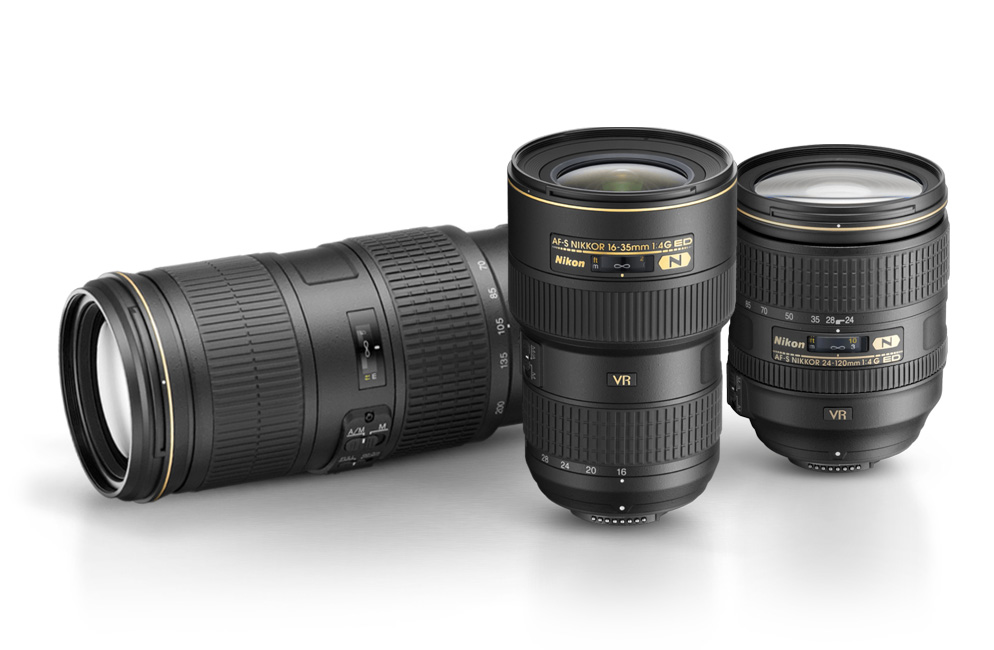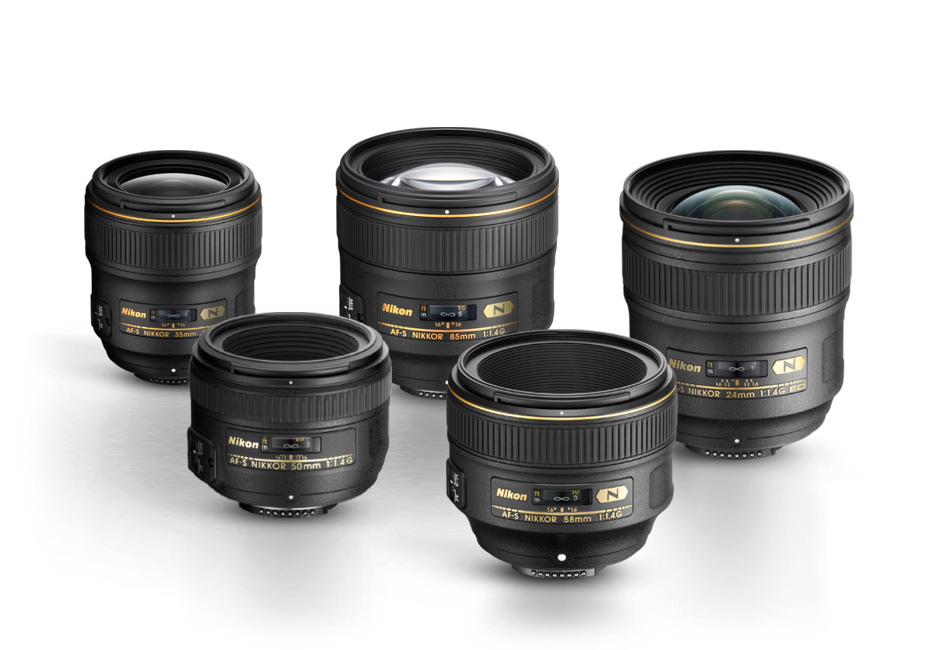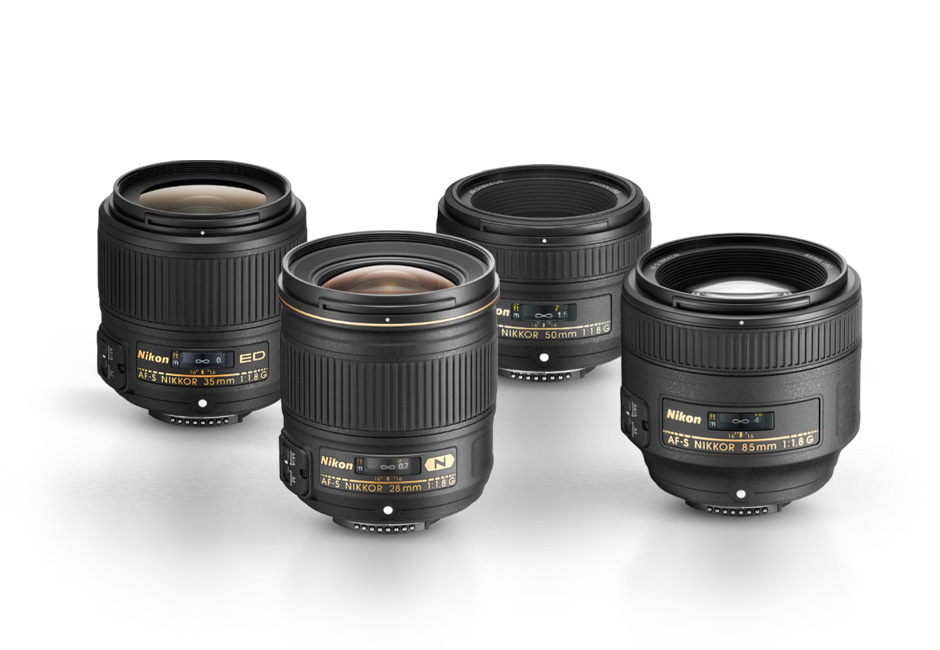Popular Nikon Lenses for Shooting Video
One of the biggest advantages of shooting video with a DSLR camera is the great lens selection available to shoot with. Each lens has its own unique set of qualities and characteristics that makes it perfect for a certain scene, and this inevitably prompts users to ask—which lenses are the best for shooting video?
This is a very common question among beginners and pros—basically anyone looking to finely hone the craft of constructing a scene will pay extra care to the lens selection to ensure what the camera sees matches their vision.
So, what we are trying to say is that there is no “best” when it comes to matching a look to your vision—you own that part of the equation, and should solve accordingly. However, we are able to give you a head start in solving this challenge by telling you what the most popular Nikon lenses for video are.
Optimal Prime or Flexible Zoom:
Before we get into exact models, let’s first solve for one important factor: Primes or Zooms?
This is a question every filmmaker should first answer before going into the lens selection process. Advanced users may wish to skip ahead, but for those who are getting started and/or want a refresher, read on as we cover these two types of lenses:
• Primes: lenses that are called “prime” are lenses with fixed focal lengths. In simple terms, this means when you use a prime, you can’t zoom in or out—you’re stuck with one view. This may seem like a disadvantage, but in fact what it allows is for optics that are perfectly crafted for that one focal length, and therefore it is well understood that Prime lenses typically have superior performance because of that. In addition, prime lenses typically have lower f/stop numbers or maximum apertures, which means that they can allow more light to hit the sensor, which ultimately allows for more creative control over your video; that can mean better control over the light in the scene as well as control over the depth of field for that dreamy shallow depth of field (bokeh) look. “Prime” lenses are often referred to as “Fixed Focal Length” lenses—this is due to the “fixed” or static nature of their optics.
• Zooms: zoom lenses are lenses that allow for zooming from one focal length to another. For example, a lens that has a 24-70mm focal length range means that it can zoom from 24mm up to 70mm. These zoom lenses are sometimes referred to as “Variable Focal Length” lenses, which is a more descriptive title for what these lenses do—they allow the focal length to “vary” as you zoom in. Though zoom lenses usually cannot achieve f/stop numbers as low as prime lenses, professional grade zoom lenses can usually go as low as f/2.8, which means quite a lot of light is hitting the sensor, giving you a great amount of control over depth of field. Of course professional zoom lenses are also optimized for the range that they cover so that image quality is pristine as you zoom in and out—the advantage of the zoom is obvious, it acts as many lenses in one. To cover all the focal lengths in a zoom lens, you would need many prime lenses, which you may not be able to have with you while you are shooting—a zoom lens also means you don’t have to stop shooting to change lenses. One last quick tip regarding zoom lenses—you can calculate how many times a zoom lens zooms by dividing the longer focal length listed on the lens by the shorter focal length. A 24-70mm lens would then become 70/24 = ~3x. This means the multiplier is 3x—the higher the multiplier doesn’t necessarily mean you have a better lens, simply one that has a longer zoom capability from its base focal length.
Popular Glass:
The most popular lenses for video won’t surprise any seasoned filmmaker or even photographers for that matter, they are the most popular and desired lenses for these applications because of their superior optics and unique perspectives:
Nikon f/2.8 zoom lenses (l. to r.) AF-S NIKKOR 70-200mm f/2.8G ED VR II, AF-S NIKKOR 14-24mm f/2.8G ED and AF-S NIKKOR 24-70mm f/2.8G ED.
Zooms:
• AF-S NIKKOR 14-24mm f/2.8G ED—The NIKKOR 14-24mm is renowned as one of the sharpest lenses on the market today. The focal range of 14-24mm means you get a very wide angle of coverage while maintaining incredible sharpness across the frame. This lens is a favorite of DPs and filmmakers both in Hollywood and in the Indie scene because of its superior sharpness and unique focal length range paired with the f/2.8 aperture, which allows for more light and depth of field control.
• AF-S NIKKOR 24-70mm f/2.8G ED—With a traditional focal length range of 24-70mm, the NIKKOR 24-70mm lens is a favorite for filmmakers shooting everything from feature films to run and gun style. Its versatile range means you can easily go from shooting a wide scene, such as an interview to grabbing B-Roll. The f/2.8 aperture again means you have the flexibility of controlling light and depth of field in your scenes.
• AF-S NIKKOR 70-200mm f/2.8G ED VR II—A long time favorite of professional photographers, and quickly becoming a must in the filmmaker’s bag, the NIKKOR 70-200mm f/2.8 lens completes the trio of f/2.8 lenses that enable you to go from 14mm all the way to 200mm with a fixed f/2.8 aperture. The 70-200mm is used extensively for its ability to compress the background and create beautiful separation between subjects and the background, which can both flatter and create a sense of intimacy with the subject. The VR (Vibration Reduction) system of this lens means you can get steadier video—this becomes an important consideration when shooting run and gun style, or just shooting on the go.
Nikon f/4 zoom lenses (l. to r.) AF-S NIKKOR 70-200mm f/4G ED VR, AF-S NIKKOR 16-35mm f/4G ED VR and AF-S NIKKOR 24-120mm f/4G ED VR.
These 3 zoom lenses are the most coveted zoom lenses in Nikon’s lineup, largely because of their f/2.8 aperture; however, these professional lenses do come at a higher price, and for those working with a smaller budget, or who simply don’t plan to shoot in low-light situations and don’t need the shallow depth of field (bokeh) of a 2.8 lens, here are the f/4 lenses that would be perfect alternatives:
• AF-S NIKKOR 16-35mm f/4G ED VR—the 16-35mm covers a really great focal length range from super wide to wide; paired up with the other lenses on this f/4 list, this lens will really add to your production level by giving you great flexibility to get the wider shots for a variation of scenes.
• AF-S NIKKOR 24-120mm f/4G ED VR—great focal length range and zoom flexibility have made this a favorite lens to shoot video on DSLR cameras. This lens continues the 16-35mm range with a good overlap, meaning that if you find yourself not needing to shoot super wide shots, you will love this lens as a general walk-around lens. The f/4 aperture means you can still let in a lot of light to get the shots you need in normal shooting situations, while being able to zoom up to 5X from 24mm all the way up to 120mm. If you are shooting in scenes that have little light, the 24-70mm f/2.8 may be a better pick to maximize the amount of light hitting the sensor, but value-wise, the 24-120mm stands as a top pick for an all around great video lens to pair up with your DSLR camera.
• AF-S NIKKOR 70-200mm f/4G ED VR—once again, the 70-200mm focal length range is highly desirable by photographers and videographers alike. The difference with this lens is its superior VR assembly, which means you will get the latest generation of image stabilization, which in turn means steady video even when handholding your camera at 200mm. This is an f/4 lens. Practically speaking, the f/2.8 lets in twice as much light at f/2.8 than the f/4; but, if you are not planning on pushing the lens to f/2.8 and have enough light in the scene, this lens becomes an absolutely great lens to add to your kit—it is much lighter, with powerful VR and at significantly lower cost than the f/2.8 version.
Nikon f/1.4 prime lenses (clockwise from top left) AF-S NIKKOR 35mm f/1.4G, AF-S NIKKOR 85mm f/1.4G, AF-S NIKKOR 24mm f/1.4G ED, AF-S NIKKOR 58mm f/1.4G and AF-S NIKKOR 50mm f/1.4G.
Primes:
• AF-S NIKKOR 24mm f/1.4G ED—with its wide-angle focal length, the NIKKOR 24mm f/1.4 lens is one of the primes most requested on set. The f/1.4 gives extraordinary control over depth of field and light and makes this (as well as all primes listed below with an f/1.4 aperture) a perfect choice for low light scenes.
• AF-S NIKKOR 35mm f/1.4G—the NIKKOR 35mm f/1.4 lens continues the focal length range coverage that the 24mm started and bridges the gap between the 24mm and the 50mm lenses.
• AF-S NIKKOR 50mm f/1.4G—the standard for both photographers and filmmakers—it is a commonly held belief that everyone should have a 50mm lens in their kit bag, and video is no exception. This 50mm lens has an f/1.4 aperture that enables further depth of field control. Its natural focal length makes it an all around great and compact lens for most shooting situations, from interviews to run and gun documentary style.
• AF-S NIKKOR 58mm f/1.4G—with a longer focal length than the standard 50mm, the NIKKOR 58mm f/1.4 pairs up an ability to render scenes beautifully without distorting points of light (making it perfect for night scenes) with a unique 58mm focal length which allows for flattering portraits/interviews as well as more flexibility when you are cropping video in-camera.
• AF-S NIKKOR 85mm f/1.4G—a very highly requested lens from filmmakers, the NIKKOR 85mm f/1.4G’s popularity stems from its longer than normal focal length, which allows for very flattering interviews and character shots, as well as for incredible control over depth of field with its f/1.4 aperture.
Nikon f/1.8 prime lenses (l. to r.) AF-S NIKKOR 35mm f/1.8G ED, AF-S NIKKOR 28mm f/1.8G, AF-S NIKKOR 50mm f/1.8G and AF-S NIKKOR 85mm f/1.8G.
You’ve likely noticed the pattern in these prime lens selections—they are all f/1.4 lenses. This shouldn’t surprise any seasoned filmmaker or photographer, however, in reality the f/1.4 does come at a higher cost, so it may not be practical or possible to have all of these lenses for a shoot. Because of that, we’ve also created a list of the most popular f/1.8 lenses that can be used in place of the f/1.4 for those working with a tighter budget.
• AF-S NIKKOR 28mm f/1.8G—the NIKKOR 28mm is the starting point for the f/1.8 lens line (FX) and provides a wider perspective to your shots. Because it is an f/1.8 maximum aperture, it is smaller, lighter and less costly than the 24mm f/1.4. Be sure to read on to understand the main impact that f/1.4 and f/1.8 have on your video. You’ll see that for most purposes the f/1.8 lenses listed here will suit your needs just fine.
• AF-S NIKKOR 35mm f/1.8G ED—just like its f/1.4 counterpart, the NIKKOR 35mm f/1.8 lens is great for bridging the gap from wide to normal focal lengths. Most of all, it enables you to have an f/1.8 aperture for those scenes where extra light is needed and when your zoom lens aperture just doesn’t cut it.
• AF-S NIKKOR 50mm f/1.8G—once again, the NIKKOR 50mm is a standard in most photographer’s kit bags—the same applies to filmmakers. This normal focal length is perfect for a variety of shooting situations. Because it is an f/1.8, it is smaller, lighter and less costly than its f/1.4 counterpart; yet it still allows for similarly beautiful shallow depth of field (bokeh) and shooting in low light.
• AF-S NIKKOR 85mm f/1.8G—for its desirable focal length paired up with its f/1.8 aperture, the NIKKOR 85mm f/1.8 is great for all the same reasons listed prior, but at a lower cost. The main difference, as with all f/1.4 to f/1.8 lenses, is the amount of light that an f/1.4 lens lets through versus the f/1.8 lens plus the blurred background (bokeh) effect is more pronounced at f/1.4. The f/1.4 aperture lets in twice as much light as the f/1.8 lens, so for really low light scenes it may be best to select the f/1.4; however, in most shooting situations, because DSLR cameras are so fine tuned for low light shooting, the f/1.8 will do a great job for a fraction of the cost.
Video Lens Recap $
So there you have it, these are some of the most popular and desired lenses for video shooting with Nikon DSLR cameras. A few notes on these selections:
• All of these lenses are FX lenses. FX is Nikon’s designation for “Full-Frame” sensor, which means the size of the sensor is the size of a traditional 35mm piece of film, which is used industry wide as the standard to measure against.
• Many video shooters will gravitate towards the f/1.4 primes because of the image quality and control over the aperture, however, it is important to know that in practical applications, a mixture of f/1.8 primes, f/1.4 primes and zoom lenses make for a more versatile system.
• Fast f/1.4 primes are typically used on film sets where each scene can easily be controlled; in this setting they are used primarily for the low light capabilities as well as to get the shallow depth of field (bokeh) aesthetic. In actuality, the f/1.8 prime lenses can deliver equally stunning image quality in similar lighting conditions. Whereas the f/1.4 can go further into the dark, the f/1.8 gets you very close, and if extra light is needed, then tweaking the camera settings (ISO) gets you there.
• Wide apertures such as f/1.8 & f/1.4 have such shallow depth of field that ensuring subjects are in focus can be challenging. Most filmmakers end up stopping these lenses down to f/2.0 or f/2.8 to gain more depth of field and not have to worry about whether their subjects are in focus. This is why for documentary or run and gun filmmaking, a good zoom lens will be preferred to a fast prime.
• VR (Vibration Reduction) image stabilization is built into some of the best zoom lenses. Using a lens without VR can be a deal breaker if you’re shooting on the go as it can be really hard to steady the video when shooting handheld. So if you need a little help steadying your footage a zoom lens may be preferable because of its built-in VR.
What are the best lenses for you to shoot video with? That decision is one only you can make, based on your specific artistic vision and needs. A typical run and gun filmmaker would have the following combination of lenses for video:
• AF-S NIKKOR 14-24mm f/2.8G ED
• AF-S NIKKOR 24-70mm f/2.8G ED
• AF-S NIKKOR 70-200mm f/2.8G ED VR II
If you were on set shooting a feature film, you may find the DP carrying the following lenses in his production cart:
• AF-S NIKKOR 14-24mm f/2.8G ED
• AF-S NIKKOR 24-70mm f/2.8G ED
• AF-S NIKKOR 70-200mm f/2.8G ED VR II
• AF-S NIKKOR 200mm f/2G ED VR II
If you were looking for a light, versatile set of lenses such as for shooting while traveling, or if you are on a tighter budget, then these lenses may do the trick in most lighting conditions:
• AF-S NIKKOR 24-120mm f/4G ED VR
As you can see, there are many ways to build a kit of lenses that fits your needs—and we’ve only scratched the surface with this article. You can add even more unique looks to your scenes with fisheye, macro and perspective control lenses. In fact, there are currently 81 NIKKOR lenses and 5 NIKKOR tele-converters available, that’s a lot of glass to choose from!
To get a little mathematical, if you were building a 5 lens kit from the 81 choices currently provided in the NIKKOR line-up, you would have 25,621,596 different combinations—that can be overwhelming. So take a deep breath, and ask yourself the following questions:
• Will I be shooting a lot of low light video? If the answer is yes, then you want to consider primes or fast zoom lenses (such as the f/2.8 lenses mentioned). If the answer is no, you would lean towards the zoom lenses.
• How important is shallow depth of field (bokeh) in my video? If it is very important, you want to consider having a few fast primes in your kit, or at least some of the f/1.8 primes. If shallow depth of field is not as important, then zoom lenses will do the trick (and some of the faster f/2.8 ones will even satisfy your depth of field (bokeh) needs).
• How often do I want to change lenses? If you don’t want to change lenses, go with the zoom lenses—if you are on set or have the ability to swap lenses without issue, then primes can be a consideration.
So go ahead and have your pick of lenses to add to your kit—ultimately you will find that the best lens setup is the one that matches your vision; and when it comes to versatility, nothing beats having some of the key zoom lenses paired with a couple of primes to get you the look you need in low light.









